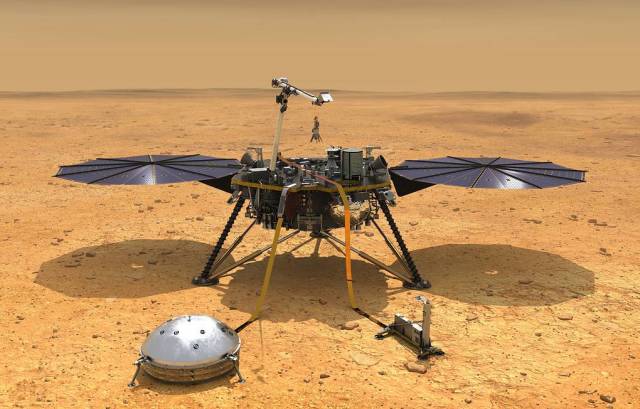Researchers suggest that it may be the cause of marsquakesTASS, October 27.
The scientific team of the InSight mission has received the first evidence that reserves of liquid magma can still be hidden in the depths of Mars, potentially capable of participating in manifestations of volcanic activity. The scientists' findings are published in the journal Nature Astronomy.
"We have recorded a series of earthquakes whose epicenters are located inside the same tectonic structure - the Cerberus Furrow. This region of Mars generates about half of the total level of seismic activity of the entire planet. Analysis of these shocks shows that the Cerberus Furrows represent a unique region of the planet where tectonic activity is generated by current magmatic processes and accelerated heat release," the researchers write.
The InSight lander landed on the surface of Mars in December 2018 to search for marsquakes and study the internal structure of the planet. Already in the first six months of work, he recorded about 170 marsquakes, which helped scientists determine the size of the core of Mars, as well as its crust and mantle.
The scientific team of the mission, led by Bruce Banerdt, head of the InSight project at NASA, used the lander's seismograph for the first time to compile a seismic map of one of the youngest regions of Mars, the so-called Cerberus Furrow. To do this, scientists analyzed the data that the SEIS seismograph collected during observations of the seismic activity of Mars over the past four years.
Magma on MarsIn total, during this time, scientists have recorded over 1.3 thousand marsquakes, a significant part of the epicenters of which were located on the territory of the Cerberus Furrow.
This further increased geologists' interest in this region of Mars and forced them to study detailed three-dimensional images of the surface of the Cerberus Furrows obtained using the instruments of the Mars Global Surveyor probe.
A comparison of the foci of seismic activity detected by SEIS in the Furrows of Cerberus with the topography of the area indicated that several dozen of them were located inside a well-visible sinkhole in the images, where scientists assume there is a graben. This is what geologists call deepened areas of the crust located below their neighbors due to the fact that they are located inside tectonic faults.
Subsequent study of these seismic tremors indicated that they occurred at a relatively shallow depth compared to other marsquakes. In addition, scientists have found in the data from the Mars Odyssey probe that this region of Mars emits significantly more heat into the surrounding space than the neighboring areas of the Cerberus Furrows.
According to Banerdt and his colleagues, all this, as well as some features in the mechanism of the birth of seismic vibrations, speak in favor of the fact that they were generated by the movement of magma in the subsurface layers of the subsurface of Mars. Further observations using SEIS, scientists hope, will help them clarify the source of these fluctuations and understand whether this magma is capable of causing full-fledged manifestations of volcanic activity.

